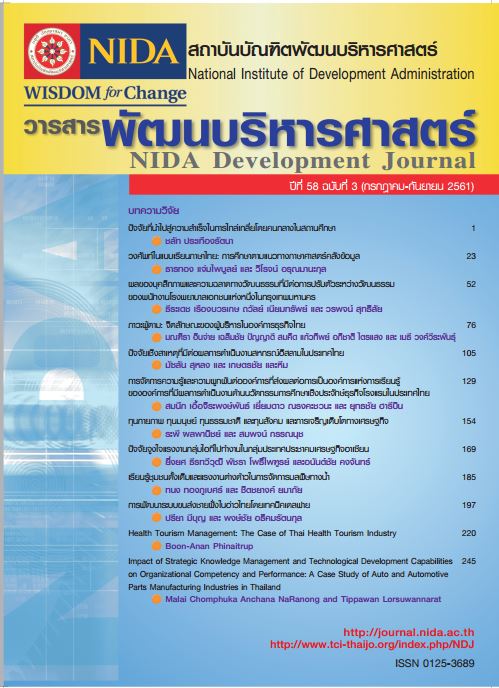Vocabulary in Thai Textbooks: A Corpus-based Study
Keywords:
corpus-based study, vocabulary, Thai textbookAbstract
This study analyzed vocabulary in Thai textbooks used for teaching children ranging from preschool to the twelfth grade, which was categorized into four levels of education. The hypotheses of this study were 1) the vocabulary of textbooks in the higher levels subsumed vocabulary in the lower levels; 2) the number of three-syllable words and opaque words in higher levels were higher than those in the lower levels; and 3) the same verb found in the higher levels had more meanings and usages than those in the lower levels. According to the list of vocabulary taken from three-million-word Thai Textbook Corpus, it was found that the vocabulary in the higher levels did not include every word in the lower levels. In terms of word difficulty, the findings revealed that the number of three-syllable words, and the opaque words tended to increase in the higher levels. As a result, these factors could be used to indicate the difficulty of vocabulary. However, in the case of high frequency words with multiple meanings like the verbs ‘go’ (/paj/) and ‘come’ (/maa/), it was found that there was no increment of meanings according to the levels of education since all of the meanings of both words were already used at the first level. Besides, the findings indicated that the vocabulary in level 2 (4th-6th grade) had the widest range of vocabulary, which contributed to the increasing number of vocabulary of learners more than other levels did.
References
กิตติพงษ์ ทวีวงษ์. (2538). การศึกษาเปรียบเทียบระดับความยากง่ายต่อการอ่านของหนังสือพิมพ์บางกอกโพสต์และเดอะเนชั่น. นิเทศศาสตรมหาบัณฑิต, จุฬาลงกรณ์มหาวิทยาลัย.
เกรียงไกร วัฒนาสวัสดิ์. (2544). หน่วยสร้างกริยาเรียง ลักษณะร่วมจำเพาะบริเวณภาษาเอเชียตะวันออกเฉียงใต้. วารสารมนุษยศาสตร์, 9, 94-109.
เฉลิมลาภ ทองอาจ. (2557). ปัญหาอ่านไม่ออก เขียนไม่ได้: แนวทางแก้ไขอย่างเป็นรูปธรรม เข้าถึงเมื่อ 27 เมษายน 2559, จาก http://www.oknation.net/blog/Chalermlahp/2014/11/02/entry-1
ชาฎินี มณีนาวาชัย. (2551). การศึกษาสมมูลภาพในการแปลคำกริยา "ไป" และ "มา" ในภาษาไทยเป็นภาษาเยอรมันในงานวรรณกรรมนวนิยายแปล. อักษรศาสตรมหาบัณฑิต, จุฬาลงกรณ์มหาวิทยาลัย.
นววรรณ พันธุเมธา. (Ed.) (2555) คลังคำ (6 ed.). กรุงเทพฯ: อมรินทร์.
พจนานุกรมฉบับมติชน. (2547). กรุงเทพฯ: มติชน.
เพียรศิริ วงศ์วิภานนท์. (2531). คำซ้อนในภาษาไทย ตอนที่ 1: ลักษณะพิเศษของคำซ้อน. ภาษา, 5(3), 15-28.
ราชบัณฑิตยสถาน. (Ed.) (2556) พจนานุกรม ฉบับราชบัณฑิตยสถาน พ.ศ. 2554 (2 ed.). กรุงเทพฯ: ราชบัณฑิตยสถาน.
Bauman, J. About the General Service List Retrieved 2015, from http://jbauman.com/gsl.html
Carroll, J. B., Davies, P., & Richman, B. (1971). Word Frequency Book. New York: American Heritage Publishing.
Coxhead, A. (2000). A New Academic Word List. TESOL Quarterly, 34(2), 213-238.
Fry, E. (1980). The New Instant Word List. The Reading Teacher, 34(3), 284-289.
Gouverneur, C. (2008). The Phraseological Patterns of High-Frequency Verbs in Advanced English for General Purposes: A Corpus-Driven Approach to EFL Textbook Analysis. In S. G. Fanny Meunier (Ed.), Phraseology in Foreign Language Learning and Teaching. Amsterdam: John Benjamins.
Loraine, S. (2008). Vocabulary Development Retrieved 25 June 2015, from http://www.superduperinc.com/handouts/pdf/149_VocabularyDevelopment.pdf
McEnery, T., Xiao, R., & Tono, Y. (2006). Corpus-Based Language Studies: An Advanced Resource Book. New York: Routledge.
Nagy, W. E., & Anderson, R. C. (1984). How Many Words are There in Printed School English? Reading Research Quarterly, 19(3), 304-330.
Richards, B. (1987). Type/Token Ratios: what do they really tell us? Journal of Child Language, 14(02), 201-209. doi: 10.1017/S0305000900012885
West, M. (1953). A General Service List of English Words. London: Longman.
Xue, G., & Nation, I. S. P. (1984). A University Word List. Language Learning and Communication, 3(2), 215-229.
Translated Thai References
Bandhumetha, Navavan. (Ed.) (2012). Khlang-Kham (6 ed.). Bangkok: Amarin. (In Thai)
Department of Curriculum and Instruction Development, Ministry of Education. (1989). The Studying of Basic Words Using in Thai Language Teaching for the Elementary Education (Vol. 1). Bangkok: Khurusapha Ladprao. (In Thai)
Maneenavachai, Chadinee. (2008). A Study of Equivalence in Translating the Verbs “Pay” and “Maa” in Thai into German in a Translated Novel. Master of Arts (Linguistics), Chulalongkorn University. (In Thai)
Matichon Dictionary. (2004). Bangkok: Matichon. (In Thai)
Thavevong, Kittipong. (1995). A Comparative Readability Study of the Bangkok Post and The Nation. Master of Arts (Communication Arts), Chulalongkorn University. (In Thai)
The Royal Institute. (Ed.) (2013). The Royal Institute Dictionary B.E. 2554 (2 ed.). Bangkok: The Royal Institute. (In Thai)
Thong-art, Chalermlahp. (2014). Illiteracy problem: The concrete solving method Retrieved 27 April 2016, from http://www.oknation.net/blog/Chalermlahp/2014/11/02/entry-1 (In Thai)
Vongvipanond, Peansiri. (1988). Semantic Doublets in Thai: Part 1: Special Characteristic of Semantic Doublets. ‘Bhasa’ Journal, 5(3), 15-28. (In Thai)
Wattanasawat, Kriangkrai. (2001). Serial Verb Constructions: the Specific Co-dominance of South-East Asia language Area. Journal of Humanity, 9, 94-109. (In Thai)
Downloads
Published
How to Cite
Issue
Section
License

This work is licensed under a Creative Commons Attribution-NonCommercial-NoDerivatives 4.0 International License.





